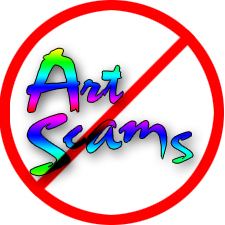January 2012
Art Scams | As if an artist’s life wasn’t tough enough!
11/01/12 13:39 Filed in: Art Business|Scams
 I just ran across a blog by artist Kathleen McMahon that is a must read for all of us! It is focused on scams that artists fall prey to, giving chapter and verse to a pitfall we are all susceptible to!
I just ran across a blog by artist Kathleen McMahon that is a must read for all of us! It is focused on scams that artists fall prey to, giving chapter and verse to a pitfall we are all susceptible to!Art scams usually work something like this:
You get an email from some exotic place. Emma David (or Richard Aaron Graham, or Curtis Thompson, etc) just has to have one of your paintings. They say some nice things and ask if it’s available and how much, where to send the check, etc. If you answer back- and there’s no reason no to- they have set the hook. You think you’ve got an interested client, but in reality, they’ve got a potential mark. The next email with the order will mention something about needing to use XYZ Shipping (someone you’ve never heard of) because, well, UPS, FedEx, DHL, etc. just don’t know how to handle customs and XYZ Shipping does. The client has had good luck with them in the past so they want to use them again. This is, of course, absurd. All major shippers… even the US Post Office… deal with foreign customs every day! The scammer asks you to charge an extra, extremely exorbitant, amount on their credit card or sends you a check for an amount far over the cost of your work (we’re talking $1000+) to cover the fees that the XYZ Shipping will request of you. The idea is that you will send the extra money to XYZ who will pick up the load from your studio. Guess what, the credit card or check is stolen! The scammer knows that the bank will take 4-6 weeks to find the error and charge you back, meanwhile, the scammer is gone and you are out the $1000+. They may even ask for a refund before the shipping company has had a chance to pick up the artwork and you end up sending them a check for the original amount!
What you should know is that the unknown shipping company… well, it’s really the scammers. The XYZ shipping company doesn’t actually exist. When you send them money- even though it seems like a legitimate sale, the scammers have scored.
Scammers count on us not understanding how Internet marketing, banking, foreign fulfillment, and customs work. The scams are often arcane and convoluted, but in the end, you end up sending them money.
Here are some basic tips to avoid these traps:
- Google the person’s name. If it’s a scam, it will probably show up in a scam alert site like Kathleen’s.
- Be wary of any order from outside of your country. Foreign orders are exciting and can be very lucrative, but most of the scams rely on our unfamiliarity in dealing across borders.
- If the client wants you to use an unknown shipper, check that shipper out online. A simple Google search should provide authenticating information.
- If the shipper is located in one of the more suspect areas of the world… Nigeria, Russia, Malaysia, for example… be very wary.
- If the client insists that you handle dealing with the unknown shipper. Try telling your potential client that you have an established account with UPS or FedEx, have shipped to their country numerous times without any problems, and that you prefer to work with that shipper. Sit back and watch what happens. If they say, “Fine, we can do it that way.” Or tell them that you normally insist that overseas clients handle the shipping arrangements, but you’ll be happy to do so for a handling fee of $800. If they don’t balk at that, they are definitely a scammer!
- If an order is cancelled after it’s been paid for with a check but before you have a chance to ship it, hold off on sending a refund check until the original check has actually cleared the bank. It might even be a good idea to check with the bank to see if it’s been reported stolen.
- If a credit card client requests a refund, always do so with a credit to the card. Never issue a check as a refund toward a credit card purchase in these situations. Scammers have all kinds of sob stories about how they need the money right away (their cat needs a tumor removed, they’ve been robbed and need money to get home, or&hellip

- Wire transfers are necessary in some countries (China, for example) and often convenient in others, but the barriers against using them for fraudulent purposes are low. If you are sending money to someone using Western Union on behalf of a client purchasing something from you… there’s a high probability that you are the victim of a scam.
- If you read this and realize that you are the victim of a scam, don’t send them any more money! There is nothing you can do to get your money back. There is no one you can call that will force or negotiate its return. No amount of additional money to anyone will get you the original funds back.
There are a few things you can do to help put an end to the scammer.
- Talk about it in your blog, twitter tweets, Facebook and LinkedIn posts. Sunlight cures scams.
- If you are approached by a scammer, contact your local law enforcement organization. Many have a scam abatement task force.
- Here’s a tip from Kathleen- If you are sure that you are being scammed, report the credit card as stolen to the bank, but tell the scammer it was declined (they expect that it will be eventually) and ask for another. Keep doing that until they give up on you. This actually hurts them as they have paid money for these numbers and you’ve just crunched a bunch of them!
So again, Check out Kathleen McMahon’s Blog and her Stop Art Scams page on Facebook Oh, and while your at it, take a look at her artwork, too!
